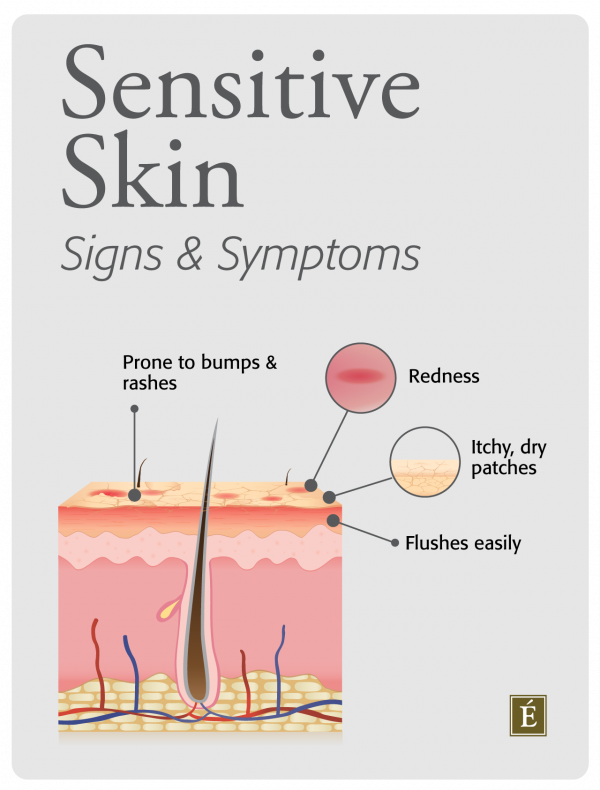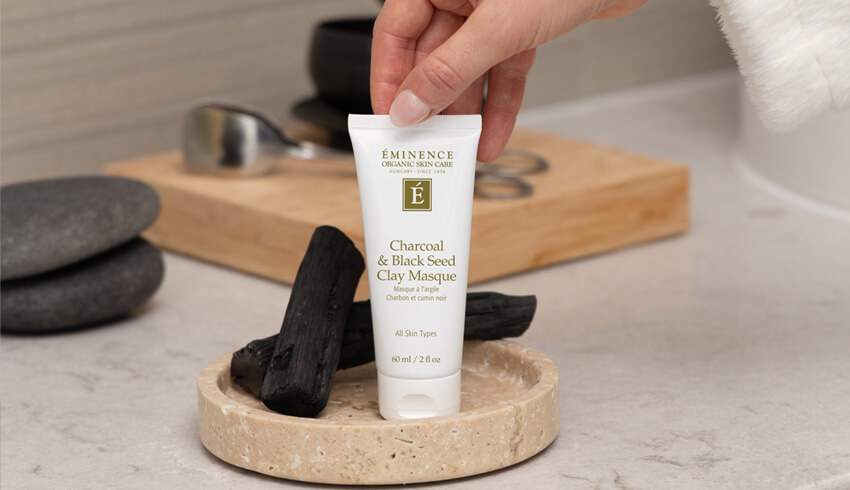
Does your skin have a sensitive side? Caring for this skin type can be a struggle — and choosing the right skin care products can feel like rolling the dice. One misstep and you could aggravate your temperamental complexion, bringing about a variety of uncomfortable symptoms. Here is everything you need to know about sensitive skin, as well as our tips for keeping it calm, cool and collected.

What Is Sensitive Skin?
With its wide variety of symptoms, sensitive skin does not manifest the same way for everyone. Its severity can range from moderate discomfort to severe reactions, and its frequency can fluctuate from the occasional flare-up to more persistent, daily sensitivity. If you are already certain you have sensitive skin, check out this skin care routine designed for your skin type.
Eminence Organics Product Support Representative and Certified Esthetician Josie Barton says: “Sensitive skin is typically described as skin that endures the regular occurrence of unpleasant sensations such as heat, stinging, burning and tingling caused by forms of stimulation that wouldn’t normally create this type of reaction in a ‘normal’ skin type.” This skin type frequently experiences unpleasant sensations like heat, stinging, burning and tingling from stimuli that wouldn’t typically cause such reactions in normal skin.
Irritant Sensitivity vs. Allergic Sensitivity
According to Dr. Hooman Khorasani, Dermatologic and Cosmetic Surgeon, there are two different types of sensitivity — irritant sensitivity and allergic sensitivity.
“An irritant sensitivity is something that irritates everyone’s skin and is independent of your immune system. Although most skin reacts to an irritant, someone with sensitive skin would see a more dramatic reaction,” explains Dr. Khorasani. These symptoms may include itchiness, redness, dryness, rashes or breakouts. In comparison, an allergic sensitivity is dependent on your immune system, and it requires prior exposure to the allergen. Because an allergic sensitivity is due to each specific immune system, unlike an irritant sensitivity, only a portion of the population is impacted.
Regardless of the causes, sensitive skin is a skin type, caused by a genetic predisposition to skin sensitivity and irritation. It’s also a common symptom of genetic conditions like psoriasis, eczema and rosacea. You can’t change your skin type, but you can adjust your daily habits and skin care routine to manage its symptoms.

How To Know If You Have Sensitive or Sensitized Skin
Another point of confusion with your potentially sensitive skin is whether it’s sensitive at all — or whether it’s actually sensitized. Sensitized skin is a skin condition, which is characterized by skin irritation that builds over time due to environmental influences and lifestyle choices. Skincare by Alana says: “Some of the biggest factors causing sensitized skin are pollution, stress and alcohol consumption.” Unlike sensitive skin, the symptoms of sensitized skin can be “fixed” over time with targeted skin care products and lifestyle changes.
Sensitive and sensitized skin share a key characteristic — a compromised lipid barrier. Your skin’s lipid barrier is its protective, fatty outer layer that performs two functions: It keeps water in and environmental stressors (like UV rays, harsh chemicals and pollution) out. Emily Newsom, MD tells SELF: “You can think of your skin barrier like a brick wall put together with mortar between the skin cells.” In sensitive or sensitized skin, that mortar has been weakened and is more permeable. When an irritant sneaks through the lipid barrier, your immune system issues an inflammatory response. That response, characterized by redness, pain and itching is what you experience as sensitivity.
Sensitive Skin Symptoms & Signs
Signs of sensitive and sensitized skin also overlap. However, sensitized skin symptoms often disappear once its lipid barrier has been repaired, while in sensitive skin they tend to be more persistent. Both display a range of symptoms that occur minutes to hours after contact with a particular ingredient or environmental trigger. Here are five telltale signs of sensitive skin:
1. Flushes Easily
Whether your face turns red after cleansing or just from facing a gust of chilly wind, your skin’s propensity to flush is a sign that its barrier function is compromised.
Everyday Health says: “Whether your face turns red after cleansing or just from facing a gust of chilly wind, your skin’s propensity to flush is a sign that its barrier function is compromised.” This redness results from an inflammatory response, with blood rushing to the skin’s surface to promote healing.
2. Prone to Rashes & Bumps
When sensitive skin on the face is exposed to a trigger, it will often react with a red, flaky or bumpy rash. Healthgrades says this is especially true for topical products like facial serums and moisturizers that are meant to be left on the skin rather than rinsed off.
3. Itchy
Sensitive skin often feels itchy and tight, especially after using cleansers with harsh chemicals or artificial fragrances. It’s often accompanied by dryness and/or dehydration, which can also leave skin feeling prickly and parched.
4. Beauty Products Sting or Burn
Dr. Elizabeth Tanzi tells Allure: "You know you have sensitive skin if the majority of the products you place on your skin causes stinging or redness." Because sensitive skin has a broken lipid barrier, fragrances and active ingredients can penetrate more easily and deeply, causing a stinging, burning or prickling sensation.
5. Reactions to Fragrance
Dermatologists agree that fragrance is one of the most notorious causes of skin irritation and sensitivity. From laundry detergents to personal care products, many consumer goods contain synthetic fragrances that can cause a reaction in sensitive skin.
In addition to avoiding triggers, you can follow a sensitive skin care routine with gentle products free of harmful chemicals like added parabens, petrolatum, mineral oils, propylene glycol or sodium lauryl sulfate. Look for comforting ingredients like chamomile, calendula and stone crop which heal and soothe redness.
Are you unsure whether you have sensitive skin? Watch this In The Mix as Lead Skin Care Trainer Natalie Pergar demonstrates three easy steps for categorizing your skin.
To learn more about what you can do for sensitive skin, check out this step-by-step skin care routine designed for your skin type. Let us know in the comments below or on social media how you cope with your skin type.


